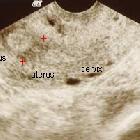spectrum of abnormal placental villous adherence

Placenta
accreta • Variation in placental adherence: diagrams - Ganzer Fall bei Radiopaedia
The spectrum of abnormal placental villous adherence describes the degree to which there is an invasion of chorionic villi into the myometrium because of a defect in the decidua basalis.
Epidemiology
- placenta accreta:
- the commonest type of placental invasion (~75% of cases)
- occurs in ~1 in 7,000 pregnancies
- combination of previous C-section and an anterior placenta previa raises the probability of a placenta accreta
- maternal mortality of up to 7% depending on location
- placenta increta:
- ~25% of cases
- occurs in ~1 in 50,000 pregnancies
- placenta percreta:
- ~5% of cases
The incidence of all forms of abnormal placental villous adherence is increasing, which is felt to be due to the increased practice of cesarean sections
Risk factors
- prior cesarean section
- placenta previa
- advanced maternal age
- uterine anomalies
- intrauterine adhesion bands
- previous surgery
Pathology
Placental villous adherence is classified on the basis of the depth of myometrial invasion:
- placenta accreta:
- mildest form
- villi are attached to the myometrium but do not invade the muscle
- placenta increta:
- intermediate form
- villi partially invade the myometrium
- placenta percreta:
- severest form
- villi penetrate through the entire myometrium or beyond serosa
Radiographic features
Definite imaging features can vary depending on the extent of invasion.
Ultrasound
- may show placenta previa
- may show placental lacunae
- variably-sized vascular structures in the placenta creating a "moth-eaten" or "Swiss cheese" appearance.
- can be seen as parallel linear vascular channels extending from placental parenchyma into the myometrium: they tend to show turbulent flow (cf. placental venous lakes show laminar flow)
- abnormal color Doppler
- turbulent flow, i.e. disruption of the normal continuous color flow in the myometrium
- increased vascularity is seen in the myometrium, and even in the urinary bladder in cases of placenta percreta
- loss of retroplacental clear space
- reduced myometrial thickness: anterior myometrial thickness <1 mm
MRI
MR images may show:
- placenta previa
- uterine bulging
- heterogeneous signal intensity within the placenta
- dark intraplacental bands on T2 weighted images
- focal interruptions of myometrial wall
- tenting of the urinary bladder
- direct visualization of the invasion of pelvic structures by placental tissue
Siehe auch:
- Placenta membranacea
- variation in placental morphology
- Placenta percreta
- Placenta accreta
- uterine anomalies
- Asherman-Syndrom
- kleine Plazenta
- Placenta extrachorialis
- Placenta praevia
- Placenta increta
- low lying placenta
- placental venous lakes
und weiter:

 Assoziationen und Differentialdiagnosen zu Entwicklungsanomalien der Plazenta:
Assoziationen und Differentialdiagnosen zu Entwicklungsanomalien der Plazenta:variation in
placental morphology








